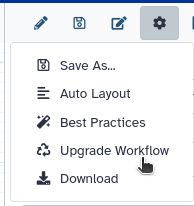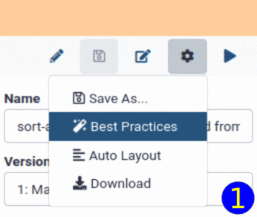This directory contains all IWC workflows.
The structure is as follows:
-
top-level directories represent categories, e.g.,
sars-cov-2-variant-calling; -
directories right under the top level represent individual workflow repositories, e.g.,
sars-cov-2-consensus-from-variationwhich will be deployed to https://github.com/iwc-workflows/sars-cov-2-consensus-from-variation; -
please, only use lower case and
-in directory names. -
workflow repository directories contain:
- the
.gaworkflow file, e.g.,consensus-from-variation.ga; - a Planemo test file, with the same name as the workflow file, but with a
-tests.ymlextension, e.g.,consensus-from-variation-tests.yml; - a
test-datadirectory with the test data used by Planemo (optional); - a Dockstore metadata file named
.dockstore.yml; - a
README.mdand aCHANGELOG.mdfile.
- the
Here are some guidelines to help new contributors to add their workflows.
Everything starts from a workflow that you have on a galaxy instance.
It is recommended to check and update tools with Planemo before import.
- You can do it from the galaxy instance using "Workflow Options" "Upgrade Workflow":
- Or by downloading the ga file and running planemo:
planemo autoupdate <workflow.ga>The best way is to check it into a galaxy instance: click on "Workflow Options", select "Best Practices" and apply the suggested improvements. In particular, in order to make the workflow usable, make sure you specify a license. Another important field is "Creator", which allows to give proper credit to the author(s). The "Identifier" field of a Creator added as a person should be filled with a fully qualified URI, e.g., https://orcid.org/0000-0002-1825-0097.
If you add an organization as Creator, you should include a "URL" field pointing to the organization's web site, e.g., https://github.com/galaxyproject/iwc.
This is usually the most difficult part and we encourage all new contributors to IWC to propose their workflows even if they did not managed to generate tests. However, the publication of these workflow will be speed up if tests are already present. To generate tests, you can either write test cases by hand, or use a workflow invocation to generate a test case (see below).
If your analysis is covered by the GTN, using GTN dataset material is a good start! If it is not, try to generate a toy dataset for example following this and then publish it to zenodo to have a permanent URL.
Create a new directory under one of the directories that represent categories. If no category is suitable you can create a new category directory.
Name the directory that contains your workflow(s) appropriately, as it will become the name of the repository deployed to iwc-workflows github organization. Only use lower-case and - in names of categories and repositories.
Execute the workflow on your Galaxy server using the smallest input data you can generate. Go to the workflow invocations page (User > Workflow Invocations), open the most recent item and find the invocation id:
You will also need your Galaxy API key. To copy it, or generate it if you don't have one yet, go to User > Preferences > Manage API Key. Then run:
planemo workflow_test_init --from_invocation <your_invocation_id> --galaxy_url <your_prefered_galaxy_instance_url> --galaxy_user_key <your_api_key>
This will place the workflow and workflow test files in your current working directory. You may still want to remove test files and edit the test comparisons so that tests will pass reliably. For example, you could consider using assertions to test the outputs, rather than comparing the entire output file with test data. Also, if some outputs are large, it is better to use assertions than storing the whole output file to the iwc repository.
Download the workflow and place it in a new directory under one of the directories that represent categories. If no category is suitable you can create a new category directory.
Name the directory that contains your workflow(s) appropriately, as it will become the name of the repository deployed to iwc-workflows github organization. Only use lower-case and - in names of categories and repositories.
You can then generate a template planemo test file with planemo:
planemo workflow_test_init <your_workflow_file.ga>If you run it on parallel-accession-download.ga, this generates the file parallel-accession-download-tests.yml:
- doc: Test outline for parallel-accession-download.ga
job:
Run accessions:
class: File
path: todo_test_data_path.ext
outputs:
Paired End Reads:
class: ''
Single End Reads:
class: ''We now need to provide inputs and outputs. You can find details about the test format in the planemo documentation. You can also check other test files into this repository to get examples. For this example workflow the final parallel-accession-download-tests.yml might look like this:
- doc: Test download of single end accession
job:
Run accessions:
class: File
path: test-data/input_accession_single_end.txt
outputs:
Single End Reads:
element_tests:
SRR044777:
file: test-data/SRR044777_head.fastq
decompress: true
compare: containsNote that we've removed the "Paired End Reads" output, since the accession we test is a single end accession.
We can now run planemo workflow_lint to make sure the workflow and its test are syntactically correct:
$ planemo workflow_lint parallel-accession-download.ga
Applying linter tests... CHECK
.. CHECK: Tests appear structurally correct for parallel-accession-download.gaBefore running the CI, it might be interesting to run your tests against a galaxy instance using planemo so you can easily see what is failing and what are the differences between your expectations and the output you get:
planemo test --galaxy_url <your_prefered_galaxy_server> --galaxy_user_key <your_api_key> <workflow.ga>If your tests are not passing because you made an error into your test file you can modify your test file and use planemo to check that the test is valid against the same invocation.
planemo workflow_test_on_invocation --galaxy_url <your_prefered_galaxy_server --galaxy_user_key <your_api_key> <workflow-tests.yml> <invocation_id>
Note: If your workflow is using build-in indexes, note that the CI will use CVMFS. You can browse the available indexes at http://datacache.galaxyproject.org/.
We now need to generate a .dockstore.yml file that contains metadata needed for Dockstore.
planemo dockstore_init operates on a directory of workflows. If your current working directory contains the workflow(s) run
$ planemo dockstore_init .
to generate a .dockstore.yml file.
We now only need a README.md file that briefly describes the workflow and a CHANGELOG.md file that lists changes, additions and fixed. Please follow the formatting and principles proposed on keepachangelog.com.
We currently do not have a user interface within Galaxy to define release versions, so you have to manually set a release: "0.1" key value pair in the workflow.ga file.
With a text editor of your choice make this change:
],
"format-version": "0.1",
"license": "MIT",
+ "release": "0.1",
"name": "Parallel Accession Download",
"steps": {
"0": {At this point you can commit the new files and open a pull request. If you are encountering difficulties at any point don't hesitate to ask for help on gitter.
RO-Crate is a format for packaging research artifacts along with their metadata in a machine readable manner. The base RO-Crate specification is complemented by a set of profiles tailored to more specific domains: in particular, Workflow RO-Crate can be used to package computational workflows, and Workflow Testing RO-Crate further describes how to add metadata related to workflow testing.
Workflow Testing RO-Crate metadata is automatically generated and added to the workflow repository after a PR is merged, before the repository is deployed to iwc-workflows. RO-Crate metadata is based on Schema.org annotations in JSON-LD (example). The Workflow Testing RO-Crate representation of the repository ensures its compatibility with the WorkflowHub registry and the LifeMonitor workflow health monitoring service.
To ensure that the RO-Crate metadata generation succeeds, make sure you apply the best practices described in the section on adding workflows. In particular, the conversion tool expects to find the workflow file and the Planemo test file; a README.md file is not expected, but it will be included if found. The workflow file should specify a license, a release and one or more creators among its metadata.


